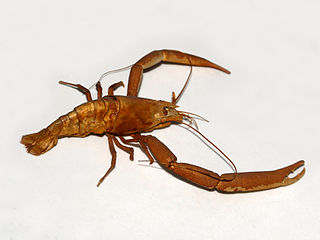
A freshwater prawn farm is an aquaculture business designed to raise and produce freshwater prawns or shrimp1 for human consumption. Freshwater prawn farming shares many characteristics with, and many of the same problems as, marine shrimp farming. Unique problems are introduced by the developmental life cycle of the main species.

Shrimp farming is an aquaculture business that exists in either a marine or freshwater environment, producing shrimp or prawns for human consumption.

Macrobrachium rosenbergii, also known as the giant river prawn or giant freshwater prawn, is a commercially important species of palaemonid freshwater prawn. It is found throughout the tropical and subtropical areas of the Indo-Pacific region, from India to Southeast Asia and Northern Australia. The giant freshwater prawn has also been introduced to parts of Africa, Thailand, China, Japan, New Zealand, the Americas, and the Caribbean. It is one of the biggest freshwater prawns in the world, and is widely cultivated in several countries for food. While M. rosenbergii is considered a freshwater species, the larval stage of the animal depends on brackish water. Once the individual shrimp has grown beyond the planktonic stage and becomes a juvenile, it lives entirely in fresh water.

Acetes is a genus of small shrimp that resemble krill, which is native to the western and central Indo-Pacific, the Atlantic coast of the Americas, Pacific coast of South America and inland waters of South America. Although most are from marine or estuarine habitats, the South American A. paraguayensis is a fresh water species. Several of its species are important for the production of shrimp paste in Southeast Asia, including A. japonicus, which is the world's most heavily fished species of wild shrimp or prawn in terms of total tonnage and represent the majority of non-human animals killed for food in terms of number of individuals.
Cryphiops caementarius is a South American freshwater shrimp.
Freshwater shrimp are any shrimp which live in fresh water.
Macrobrachium agwi is a species of freshwater shrimp, first described in 2008, endemic to the Himalaya. It was discovered when a shipment of ornamental prawns, destined for the aquarium trade, was shipped from Cooch Behar, West Bengal, India to Europe. Examination of the shipment showed that one type of shrimp was a new, undescribed species.

Macrobrachium ohione, commonly known as the Ohio shrimp, Ohio river shrimp or Ohio river prawn, is a species of freshwater shrimp found in rivers throughout the Gulf of Mexico and Atlantic Ocean drainage basins of North America. It is the best-known of all North American freshwater shrimp, and is commonly used as bait for commercial fishing, especially catfish.

Macrobrachium is a genus of freshwater prawns or shrimps characterised by the extreme enlargement of the second pair of pereiopods, at least in the male.

Macrobrachium carcinus is a species of fresh water shrimp known as the big claw river shrimp. It is native to streams, rivers and creeks from Florida to southern Brazil. It is the largest known species of Neotropical freshwater prawn, growing up to 30 centimetres (12 in) long and weighing as much as 850 grams (30 oz), although even larger specimens have been reported. It is an important species for commercial fishing in the Sao Francisco River basin, where it is known by the local name of pitu. M. carcinus is omnivorous, with a diet consisting of molluscs, small fish, algae, leaf litter and insects.

Macrobrachium formosense, the crane river prawn, is a species of freshwater shrimp in the family Palaemonidae. It lives in streams and rivers in Taiwan and southern Japan, including the Ryukyu Islands. Macrobrachium formosense reaches a carapace length of 10–20 millimetres (0.4–0.8 in).

Oriental river prawn, or East Asian river prawn is a species of freshwater shrimp found in Asia that was first described in 1849.
Macrobrachium malcolmsonii is an omnivorous, bottom-dwelling, freshwater prawn. Its common name is monsoon river prawn.
Macrobrachium vollenhoveni, the African river prawn, is a species of large, commercially important prawn from the family Palaemonidae from West Africa. It is a catadromous species that moves from freshwater to brackish water to spawn returning to freshwater as larvae. Recent research has shown that it could potentially be used as a biological control to reduce the rates of infection people living near rivers where this species occurs with schistosomiasis.

Feeder shrimp, ghost shrimp, glass shrimp, grass shrimp, river shrimp or feeder prawns are generic names applied to inexpensive small, typically with a length of 1 to 3 cm, semi-transparent crustaceans commonly sold and fed as live prey to larger more aggressive fishes kept in aquariums.

Macrobrachium scabriculum is a species of freshwater shrimp. It is distributed in countries and territories around the Indian Ocean. It is known as Goda River prawn. The total length of male prawns become about 6.5 cm long and in females it is about 5 cm. A kind of fur develop on the chelipeds of males. Eggs produced by M. scabriculum are smaller in size, brownish in color, elliptical or oval in shape and hatched larvae undergone migration to low saline water for completion its life cycle.
Macrobrachium indicum is a species of freshwater shrimp of South India. It was first described in 1986. This freshwater prawn was described from Vellayani Lake, Kerala. This species is closely related to M. australe and M. ustulatum. It is a medium-sized prawn of genus Macrobrachium.
Macrobrachium banjarae is a species of freshwater shrimp that was first described in 1958. Macrobrachium banjarae belongs to the family Palaemonidae. It is an endemic prawn found India, in the states of Andhra Pradesh, Karnataka, Madhya Pradesh, Maharashtra and West Bengal.










